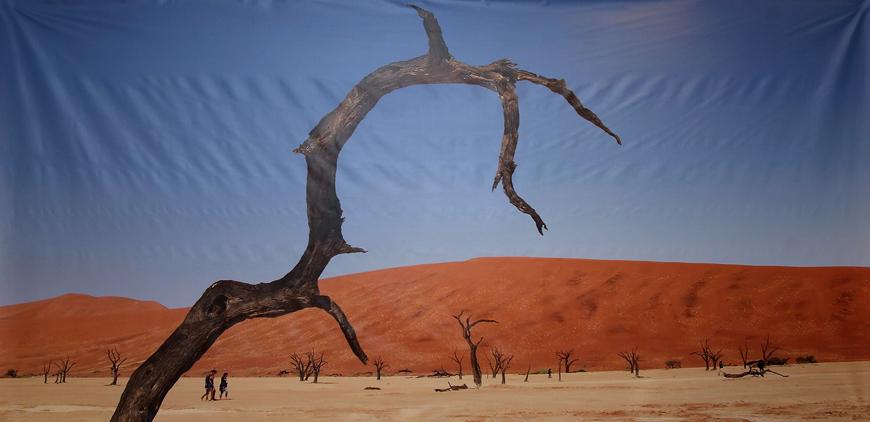You are here
‘From dust to life and back’
By Ica Wahbeh - May 03,2016 - Last updated at May 03,2016

Work from the exhibition ‘From Dust to Life and Back’ by Ivana Panizzi on display at Zara Gallery until May 11 (Photo courtesy of Zara Gallery)
AMMAN — Ivana Panizzi stays true to her avowed mission to “research and recycle non-conventional materials”, her works on display at Zara Gallery show.
The Brazilian artist exhibits photographs and installations as part of the Image Festival, a collaborative endeavour of The Institut Francais in Jordan and Darat Al Tasweer, now in its fifth edition, which usually draws important names in photography and has secured, since inception, the collaboration of several venues in Amman.
Panizzi’s works come under the provocative title “From Dust to Life and Back”, an interesting, somehow reversed, order of things that still goes full circle but in the progression dictated by the artist, who is solely responsible, as artists are, for the fate of her creations.
Her digital photographs go from small to monumental, with images of equal scale.
“Radioactive dream — trees of Kruger Park”, South Africa, is a reflection, in a perfectly symmetrical image, of white, ghostly tree branches and psychedelic brushes projected against a black background.
It is almost an X-ray image of an after nuclear blast that lingers on the retina long after seeing it, just like the effect of irradiation.
“Kelps at Cape Point”, also in South Africa, is the digital image of beautiful patterns created by intertwined branches hugging each other, huddling together, semi-putrefied — or perhaps covered with kelp?
It is a haunting photograph, like most images Panizzi creates.
Children watching a wedding procession (unseen, but declared by the artist) from a high vantage point in Mozambique are an image to behold.
Dressed in their finest, precariously perched on a concrete wall, they seem engrossed in the occasion. Three, however, became aware of the photographer’s presence and look curiously or pose with inquisitive eyes or flashing V signs.
On a “Dumping site”, again in Mozambique, people sift through the huge pile of trash, intent on salvaging whatever can be used.
Recyclers or sorts themselves, they may be some strange entrepreneurs, but are most likely the sign of a serious social problem: poverty.
More “Kelps” in South Africa assumes a shimmering blue colour, like water under a silvery full moon (or a pale setting sun).
It is a beautiful image of vastness where detritus forms geometrical patterns, becoming beautiful in the process, although it litters the pure water.
Contrasting the blue of the water, the next photograph, the “Death Valley” in the Namib Desert, is an expanse of light beige sand strewn with dry trees, eerie sculptural presences projected against a reddish dune/hill under a cloudless blue sky.
Desolate, presaging death, the landscape would be forbidding were it not for a group of people walking carefully and casually, as if a daily occurrence, through the sand.
Three images render “Hands”. Green, submerged in water and surrounded by maroon red (like consuming fire), the hand, palm up, seems to signal resignation, offering or maybe just the triumphant winning of an argument.
Smaller photos paired in two tableaux of 12 each — with each perfectly alright on its own — bring together beautiful images of marine life and parched desert that could not escape littering with modern-day objects: discarded cans, rusting metal, a bottle, a box of matches or the iconic bleached skull of an Oryx, beautiful black horns intact, who died either prey to another or of hunger in the unforgiving desert.
A Plexiglas installation on the floor holds a group of 12 images of cracked, arid soil in some desert.
Fossils (or more likely the imprint of the sole of a shoe) form strange patterns on the ochre earth, in a few instances coloured, digitally, turquoise, yellow, orange, green or dark red.
In a different room, taking the viewer by surprise, is an original installation the artist calls “in vitro”.
It is, indeed, bottles, hundreds of them, that hold digital photos of “friends, family and acquaintances”, diaphanous, transparent cut-out images immortalised in their vitreous containers.
“Bottles have always fascinated me. Beyond their multiple uses, they are constantly present in our good or bad moments, during celebrations and on special occasions.... This exhibition portrays the conceptual idea of the human effect on water and nature, natural images inside empty bottles presented as installations,” wrote the artist on the exhibition flyer.
Using these everyday practical objects to create art is original and creative.
Panizzi creates touching images of people, souls captured in a bottle for memory.
Some quietly peering from inside, others half way out, attempting to evade, the people in the photos are happy, sad, angry, resigned or determined.
They are captured in different postures — a mother hugging her child, friends embracing, fishermen with their catch, singers obviously enjoying themselves, children sad or happy, women posing for the camera.
The hundreds of images portray ethnicities, customs, states of mind, feelings and activities.
A woman has grown wings and is flying out of the bottle: an angel, a soul leaving this world.
Veiled women, all the same as the uniformity of the burqa makes them, are in corked bottles, prisoners without escape. The symbolism cannot escape the viewer.
Of all shapes and sizes (even a light bulb), the clear bottles serve an original purpose for Panizzi’s equally original art.
The artist, who is the wife of the Brazilian ambassador to Jordan, studied art at the Instituto Superior de Arte in Havana, Cuba, where, besides painting and photography, she also studied cinema and television.
Her artworks can be found in private galleries and museums in Brazil, the US, Latin America, as well as in private collections in Belgium, Bolivia, Cuba, Egypt, Ireland, Italy, Japan, Mozambique, South Africa and Tanzania.
Gripping and thought provoking, the works will be on display until May 11.













